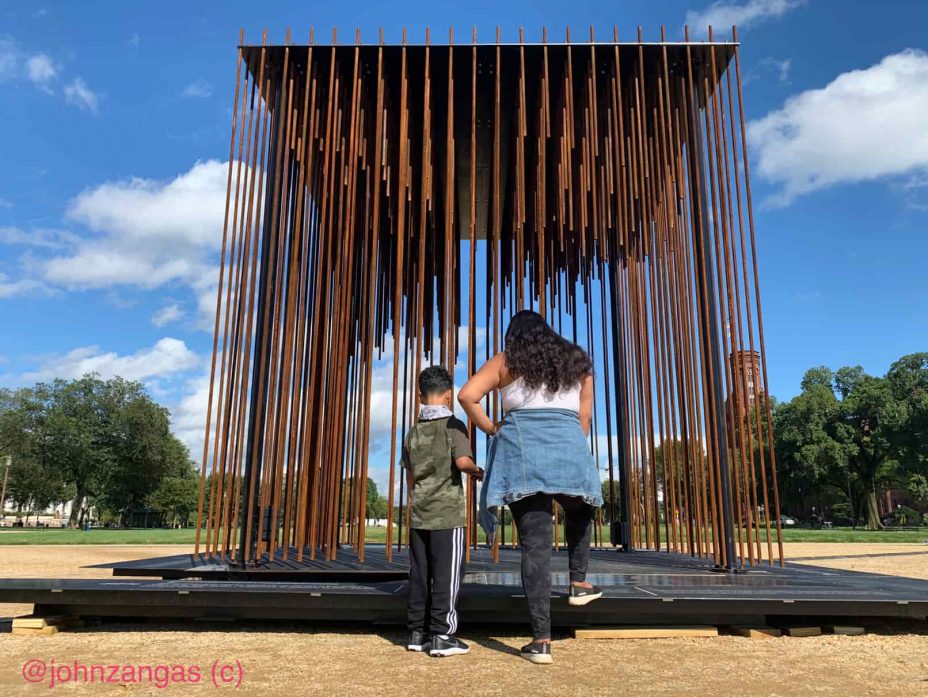Washington DC – A group of five designers at the internationally known SmithGroup Architecture firm set up a metallic cubic structure on the National Mall to frame the struggle of Black Lives in America. The public display titled “Society’s Cage” is a 14 foot cube pavilion timed for the 57th anniversary of the March On Washington and is made from the hidden components of sky scrapers. It depicts an architect’s visualization of ongoing racial inequality in the United States and asks the question, “What is the value of a Black life in America?”
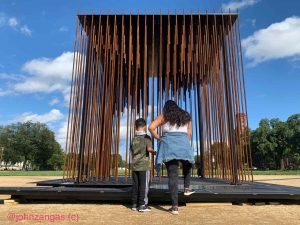
Society’s Cage is an Architect’s rendering of racial inequality in America. Photo: John Zangas
The cube is constructed from 484 vertical rusted conduit pipes attached to a large metal plate, supported by four large metal supports on a pavilion, resembling a cage. One in four bars are connected to the floor, representing the rate Blacks will be incarcerated. A four-part, 8 minute, 46 second music composition, the same period of George Floyd’s tragic murder, sets the mood. The floor is captioned with quotations of prominent civil rights activists while the pavilion’s parapet contains statistics of Black lives within the justice system. As night falls lights shimmer through the conduits, illuminating the display.
The observer is invited to walk through the cube and between the uneven hanging conduit pipes to experience the visual and acoustical expression of systemic injustice through the eyes of Black lives. “How long can you hold your breath,” greets the observer at its entrance. One enters and hears a concert of instruments accented with the cries of a child, police sirens, moans of the Black mother whose child was killed by police, the rising and falling tones of voices marking societal iniquities. Through the conduit bars one sees the Washington Monument and the U.S. Capitol, lending more context to the design’s statement: Is a Black life really free? Does a Black life really have equal access under the law in this democracy?
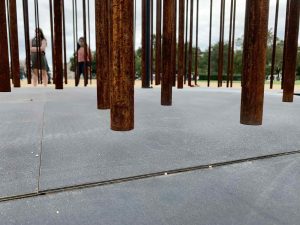
Julian Arrington, one of five designers, commented on the meaning of Society’s Cage and its impact of project development on him. “The cube depicts equity and perfection and is a symbol of equality,” he said. But he described its inner structure rendered as a critique of the broken justice system. “The bars are interrupted and converge with four datasets representing different forms of racism and state violence,” he said.
Arrington described the four data sets as mass incarceration, police brutality in the form of police killings, capitol punishment, and lynching. He suggested the display is a visual display of the continuing pattern of this systemic racism imbued within society because it was as evident today as it was 400 years ago and studies and statistics bore that out.
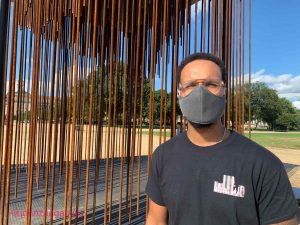
On one side of the parapet reads “One in ten Black people are killed by police while unarmed. Black people are 2.5 times more likely to be killed by police than Whites.” Another side reads, “Out of over 2600 people absolved of crimes since 1956 nearly half have been Black. In America Black people are far more likely to be wrongly convicted of murder, sexual assault, and drug crimes.”
Doug Dahlkemper, one of the principals at SmithGroup, said that the design was the Architectural firm’s contribution to a national discussion of racial issues. He said the firm supported the grassroots efforts of the designers to design and build the project. The designers, who are all minorities, took lead roles in the project. “I think we all have to be a part of this issue, Black, White, no matter what race and creed you are,” he said. SmithGroup Architecture firm was the primary supporter of the group effort which involved several supporters.
Dahlkemper credited the design team as “very skilled designers” who not only envisioned and designed Society’s Cube, but also planned the logistics and organized the fundraising needed to complete the project.
Arrington took pride in describing the project and the symbolic meaning of its constituent parts. He derived hope from the fact that his firm supported it. “The opportunity to have something on this site speaks volumes in terms not only the breath within my organization of people who want to see change but also those who sponsored and contributed financially to it,” he said.
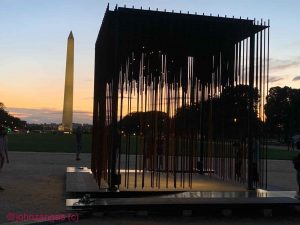
As the sun set and the conduit lights came on to mark the end the first day of the display, someone left a bouquet of roses and lillys on the welcome table. After several of the support team swept dust from the floor of Society’s Cage, Arrington carefully laid the flowers on the four corners of the parapet.
Society’s Cage.
